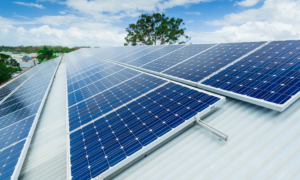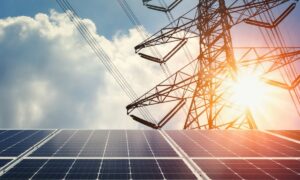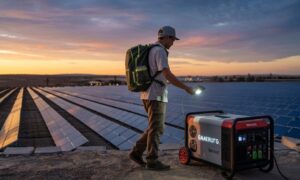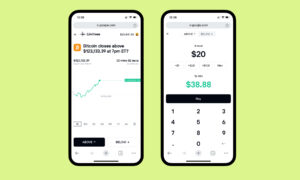Solar power is rapidly gaining popularity in residential areas as homeowners seek sustainable and cost-effective energy solutions. Central to the functionality of solar power systems are inverters, which convert the direct current (DC) generated by solar panels into alternating current (AC) used by household appliances. Among the various types of inverters, single-phase inverters stand out for their efficiency and suitability for residential applications. This article explores the advantages of using single-phase inverters for home solar systems.
What are Single-Phase Inverters?
Single-phase inverters are electronic devices that convert direct current (DC) from solar panels into alternating current (AC) with a single sinusoidal waveform for use in homes and small businesses. These inverters are designed to work with the single-phase power supply common in residential settings, which consists of two wires: one active and one neutral.
In contrast to three-phase inverters, which produce three AC waveforms 120 degrees out of phase, single-phase inverters generate a single AC output. This makes them simpler in design, more cost-effective, and easier to install than their three-phase counterparts.
In a solar power system, single-phase inverters typically connect to a string of solar panels wired in series. They often incorporate Maximum Power Point Tracking (MPPT) technology to optimize energy production by adjusting the DC input voltage. This allows the inverter to extract the maximum amount of energy from the solar panels, resulting in higher efficiency and improved overall system performance.
Key Advantages of Single-Phase Inverters for Residential Solar Systems
Cost-Effectiveness
Single-phase inverters offer significant cost advantages for residential solar installations. The initial investment is typically lower compared to three-phase inverters, making them more accessible to homeowners. Installation costs are also reduced due to simpler wiring requirements and less complex setup procedures. Moreover, maintenance expenses tend to be lower over time, contributing to long-term savings.
Simplicity and Reliability
The straightforward design of single-phase inverters translates to easier installation processes, often requiring less specialized knowledge. This simplicity extends to the overall system architecture, with fewer components involved. As a result, there are fewer potential points of failure, enhancing the system’s reliability and reducing the likelihood of malfunctions or downtime.
Energy Efficiency
Modern single-phase inverters boast high conversion efficiency rates, often exceeding 95%. This means that a greater proportion of the DC power generated by solar panels is successfully converted to usable AC power. Such efficiency is particularly beneficial for small to medium-sized residential systems, where maximizing energy output is crucial for achieving optimal return on investment.
Compatibility
Single-phase inverters are ideally suited for most residential electrical systems, which typically operate on single-phase power. This compatibility ensures seamless integration with existing home wiring, minimizing the need for extensive electrical modifications. The ease of integration not only simplifies the installation process but also reduces potential complications and additional costs.
Space-Saving
The compact design of single-phase inverters is a significant advantage for residential installations. Their smaller footprint makes them ideal for homes with limited installation space, whether indoors or outdoors. This space-saving characteristic provides greater flexibility in system design and placement, allowing for more discreet installations that don’t compromise the aesthetics of the home.
Technical Benefits of Single-Phase Inverters
Power Quality
Single-phase inverters excel in delivering stable power output tailored to residential needs. They employ advanced technologies to produce a clean sine wave, ensuring smooth and consistent electricity supply to household appliances. One of the key advantages is the reduced harmonic distortion in the output current. This lower distortion minimizes interference with sensitive electronic devices and contributes to the overall efficiency of the electrical system. As a result, homeowners can enjoy reliable power that meets or exceeds utility standards, enhancing the performance and longevity of their electrical appliances.
Voltage Regulation
Voltage regulation is a critical feature of single-phase inverters, providing consistent voltage levels crucial for residential applications. These inverters incorporate sophisticated control algorithms to maintain steady voltage output, even when faced with fluctuations in solar panel output due to changing weather conditions. This regulation protects household devices from potential damage caused by voltage surges or drops. Additionally, many single-phase inverters include built-in protective features that can quickly disconnect from the grid in case of severe voltage anomalies, ensuring the safety of both the solar system and connected appliances.
Monitoring and Control
Modern single-phase inverters come equipped with advanced monitoring features that provide real-time insights into system performance. These monitoring capabilities allow homeowners to track energy production, consumption, and overall system health through user-friendly interfaces, often accessible via smartphone apps or web portals. Furthermore, many inverters offer remote control and diagnostic capabilities, enabling users or installers to adjust settings, perform troubleshooting, or even predict maintenance needs without physical access to the device. This level of monitoring and control not only enhances system efficiency but also empowers homeowners to optimize their energy usage and quickly address any issues that may arise.
Common Misconceptions about Single-Phase Inverters
Common misconceptions about single-phase inverters often lead to confusion among homeowners considering solar installations. One prevalent myth is that single-phase inverters are significantly less efficient than three-phase inverters. In reality, modern single-phase inverters can achieve high conversion efficiency rates, often exceeding 95%.
Another misunderstanding is that single-phase inverters cannot work with three-phase power systems. However, single-phase inverters can indeed be installed in homes with three-phase power, as they will simply feed into one of the three phases. The electricity meter sums up imports and exports across all phases, ensuring homeowners still benefit from their solar production.
Some believe that single-phase inverters are not scalable for larger systems. While it’s true that three-phase inverters are typically used for high-power commercial installations, single-phase inverters can be suitable for most residential needs and can even be installed in multiples if necessary.
Lastly, there’s a misconception that single-phase inverters significantly increase electricity bills. In fact, well-designed inverters, like those from reputable manufacturers, are highly energy-efficient and have minimal impact on overall power consumption
Conclusion
Single-phase inverters offer numerous advantages for residential solar systems, including cost-effectiveness, simplicity, high efficiency, and compatibility with home electrical systems. Their compact size, advanced features, and reliable performance make them an excellent choice for homeowners looking to harness solar energy. When considering a solar installation, single-phase inverters should be at the top of your list for their ability to deliver optimal results in residential settings.



































